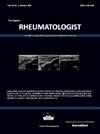Calprotectin in patients with axial spondyloarthritis: Clinical features, disease activity and imaging
IF 1
Q4 RHEUMATOLOGY
引用次数: 0
Abstract
Aim of the work
The aim of the current study was to examine both serum and fecal calprotectin (sCal and fCal) levels in patients with axial spondyloarthritis (axSpA) and to evaluate their potential relations to clinical features, disease activity and imaging.
Patients and methods
This study included 40 axSpA patients and 18 controls. Disease activity using AS disease activity score (ASDAS), sacroiliac joints radiography and magnetic resonance imaging (MRI) were assessed. sCal and fCal were measured.
Results
The axSpA patients were 57.5 % males, with a mean age of 39.8±11.5 years and a median disease duration (IQR) of 4.5 (1.7–11.5) years. The median sCal and fCal levels were significantly higher in axSpA patients compared to controls (p< 0.001). There were no differences in median sCal and fCal levels in axSpA patients concerning demographic data, HLA-B27, extra-articular manifestations, intestinal symptoms and biologics treatment (p> 0.05). A significant increase in median sCal and fCal levels along with the increase in clinical disease activity grade was found (p< 0.0001 and p= 0.003, respectively). Both sCal and fCal were significantly correlating with each other (p= 0.003), with ASDAS score (p= 0.003 and p= 0.01, respectively) and negatively with hemoglobin (p= 0.01 and p= 0.009, respectively). An increase in median sCal levels was observed along with the increase in grade severity of sacroiliitis on MRI (p= 0.06).
Conclusion
Serum and fecal calprotectin levels were significantly increased in axSpA patients and associated with disease activity. Both were having good specificity and sensitivity as potential diagnostic biomarkers for the disease.
钙护蛋白在轴性脊柱炎患者中的应用:临床特征、疾病活动性和影像学
本研究的目的是检测中轴性脊柱炎(axSpA)患者血清和粪便钙保护蛋白(cal和fCal)水平,并评估其与临床特征、疾病活动性和影像学的潜在关系。患者和方法本研究包括40例axSpA患者和18例对照组。采用AS疾病活动性评分(ASDAS)、骶髂关节x线摄影和磁共振成像(MRI)评估疾病活动性。测量cal和fCal。结果axSpA患者中男性占57.5%,平均年龄39.8±11.5岁,中位病程(IQR) 4.5(1.7 ~ 11.5)年。与对照组相比,axSpA患者的中位cal和fCal水平显著升高(p<;0.001)。axSpA患者在人口统计学数据、HLA-B27、关节外表现、肠道症状和生物制剂治疗方面的中位cal和fCal水平无差异(p>;0.05)。随着临床疾病活动等级的增加,中位鳞片和fCal水平显著增加(p<;0.0001和p= 0.003)。sCal和fCal与ASDAS评分呈显著相关(p= 0.003和p= 0.01),与血红蛋白呈显著负相关(p= 0.01和p= 0.009)。在MRI上,随着骶髂炎严重程度的增加,中位鳞片水平增加(p= 0.06)。结论axSpA患者血清和粪便钙保护蛋白水平显著升高,且与疾病活动度相关。两者都具有良好的特异性和敏感性,可作为该疾病的潜在诊断生物标志物。
本文章由计算机程序翻译,如有差异,请以英文原文为准。
求助全文
约1分钟内获得全文
求助全文

 求助内容:
求助内容: 应助结果提醒方式:
应助结果提醒方式:


